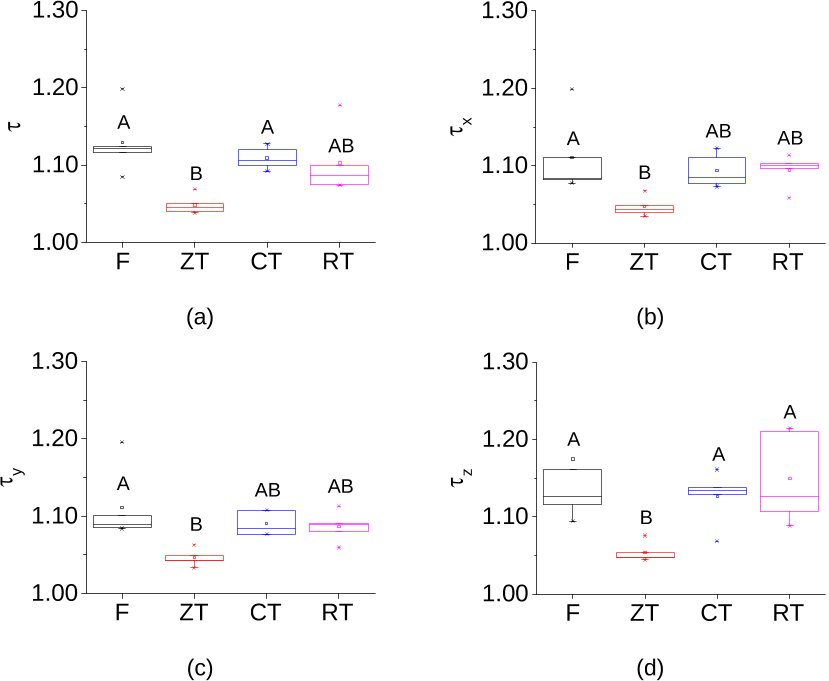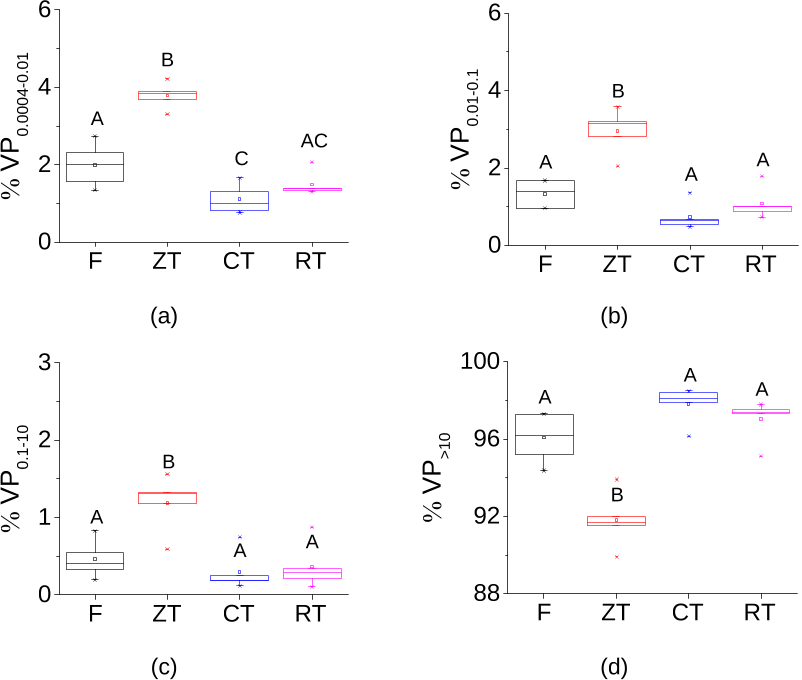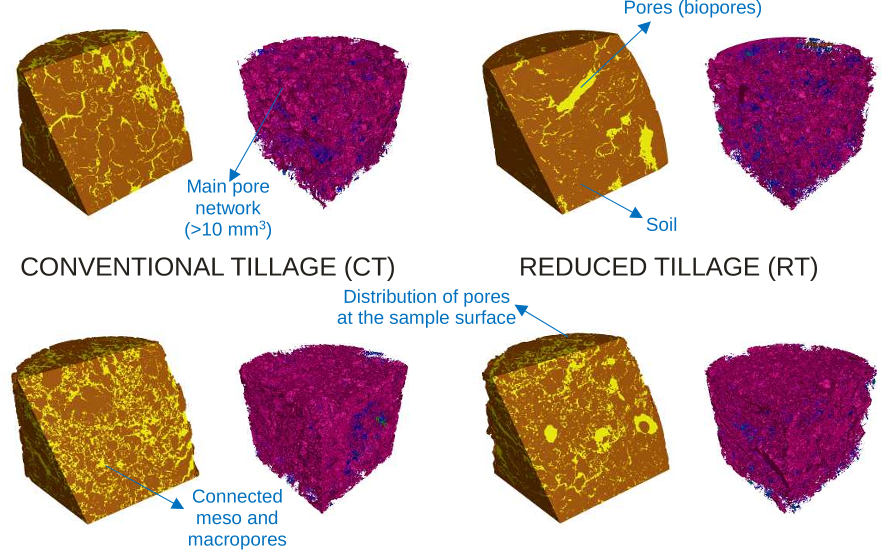
1
3D analysis of the soil porous architecture under
long term contrasting management systems by X-ray
Computed Tomography
L.F. Pires
a
, W.L. Roque
b
, J.A. Rosa
c
, S.J. Mooney
d
a
Laboratory of Physics Applied to Soils and Environment, Department of Physics, State University of Ponta Grossa,
84.030-900, Ponta Grossa, PR, Brazil
b
Petroleum Engineering Modelling Laboratory, Department of Scientific Computation, Federal University of Paraíba,
58.051-900, João Pessoa, PB, Brazil
c
Laboratory of Soil Physics, Agricultural Research Institute of Paraná, 84.001-970, Ponta Grossa, PR, Brazil
d
Division of Agricultural and Environmental Sciences, School of Biosciences, University of Nottingham, Sutton
Bonington Campus, Leicestershire LE12 5RD, UK
Corresponding author:
Prof. Dr. Luiz F. Pires, Phone: (55) 42 3220 3044. Fax: (55) 42-3220-3042
E-mail: lfpires@uepg.br (Luiz F. Pires);
Proofs should be sent to:
Prof. Luiz Fernando Pires, Departamento de Física, Universidade Estadual de Ponta Grossa,
Campus de Uvaranas, Bloco L, Sala 15B; Av. Carlos Cavalcanti, 4748, CEP 84.030-900, Ponta
Grossa, PR, Brazil.

2
3D analysis of the soil porous architecture under long1
term contrasting management systems by X-ray2
Computed Tomography3
L.F. Pires
a,1
, W.L. Roque
b
, J.A. Rosa
c
, S.J. Mooney
d
4
a
Laboratory of Physics Applied to Soils and Environment, Department of Physics, State5
University of Ponta Grossa, 84.030-900, Ponta Grossa, PR, Brazil6
b
Petroleum Engineering Modelling Laboratory, Department of Scientific Computation, Federal7
University of Paraíba, 58.051-900, João Pessoa, PB, Brazil8
c
Agricultural Research Institute of Paraná, 84.001-970, Ponta Grossa, PR, Brazil9
d
Division of Agricultural and Environmental Sciences, School of Biosciences, University of10
Nottingham, Sutton Bonington Campus, Leicestershire LE12 5RD, UK11
12
ABSTRACT13
The development of adequate soil structure is important for achieving good physical14
status, which influences the sustainability of agricultural areas. Different management15
systems lead to the development of a wide range of soil pore network characteristics.16
The objective of this research was to analyze the effect of three contrasting tillage17
systems (zero-tillage, ZT; reduced tillage, RT; conventional tillage, CT) in the soil18
porous system of an Oxisol. Samples were collected from the surface layer (0-10 cm).19
An area under secondary forest (F) was also assessed to provide an undisturbed20
reference. X-ray Computed Tomography (µCT) scanning of undisturbed soil samples21
and image analysis were employed for analysis of the pore network. The soil under ZT22
1
Corresponding author
Tel.: +55 42 3220-3044
E-mail addresses: luizfpires@gmail.com; lfpires@uepg.br (L.F. Pires)

3
had the smallest porosity in comparison to the other management systems. The23
conventionally tilled soil had the largest porosity and the most connected pores. One24
large connected pore was responsible for around 90% of the porosity of the resolvable25
pores (>35 µm) studied for all the management systems. Pores of elongated shapes,26
which enhance water movement through the soil, were the most frequent pores in27
terms of shape.28
Keywords: Minimum tillage; Zero-tillage; Conventional tillage; Morphological properties;29
X-ray microtomography; Soil structure.30
1. INTRODUCTION31
The use of tillage has been employed for centuries to improve soil structure for32
enhanced crop development. However, the choice of tillage systems can have a33
significant impact on a soil heath and quality. Sustainable farming systems greatly34
depend on soil quality (Bünemann et al., 2018). Soil tillage provokes substantial35
changes in several soil physical properties such as total porosity, bulk density, water36
retention and infiltration, penetration resistance, pore size distribution, connectivity and37
tortuosity (Imhoff et al., 2010; Daraghmeh et al., 2009; Blanco-Canqui et al., 2004;38
Katsvairo et al., 2002).39
In Brazil the adoption of minimum tillage systems such as reduced (RT) and40
zero tillage (ZT) is common. The total Brazilian area used in crop production is around41
66 million hectares and there are over 31 million hectares under ZT (FEBRAPDP,42
2013). Conventional tillage (CT) is characterized by the disruption of the top soil due to43
ploughing and harrowing operations employed to turn over and loosen the soil. As a44
result of these operations, macropores are created and pore continuity is disrupted,45
which directly affect the water movement (e.g. hydraulic conductivity and infiltration)46
and retention (Blanco-Canqui et al., 2017; Ogunwole et al., 2015; Cássaro et al., 2011;47
Imhoff et al., 2010). Minimum tillage systems such as RT and ZT do not usually lead to48

4
drastic soil structure changes. These systems, known as conservation techniques,49
have been utilized as a means of reducing tillage and field costs as well as for50
conserving soil structure due to reduced disturbance (Aziz et al., 2013; Cavalieri et al.,51
2009). The residues of the previous crop are left intact and the absence of harrowing in52
ZT and RT can increase soil organic carbon and aggregate stability, reduce CO
2
53
emissions and moderate fluxes of water, air and heat through the soil (Aziz et al., 2013;54
Daraghmeh et al., 2009; Zibilske and Bradford, 2007).55
The fluxes of water and air, organic matter decomposition, plant-available water56
and soil resistance to erosion are directly linked to the architecture of the soil porous57
system. Mesopores and macropores play an important role in these processes (Imhoff58
et al., 2010; Fuentes et al., 2004; Cameira et al., 2003). In CT, the soil porous system59
is affected by operations such as ploughing and harrowing, which can increase porosity60
and loosen soil (Mangalassery et al., 2014). This operation allows good root growth61
and air exchange, while the exposition of the soil to rain in tropical regions can62
sometimes lead to erosion (Alvarez et al., 2009). On the other hand, the activity of63
earthworms and root decay help to create channels and burrows under RT and ZT,64
which facilitate drainage and gaseous diffusion (Soto-Gómez et al., 2018; Carducci et65
al., 2017; Pires et al., 2017; Pierret et al., 2002).66
Based on the important functions that mesopores and macropores fulfill for a67
healthy soil, techniques to image and measure key properties such as X-ray Computed68
Tomography (µCT) are very important (Tseng et al., 2018; Yang et al., 2018; Ferreira69
et al., 2018; Pagenkemper et al., 2014). The spatial distribution of pores can be non-70
destructively imaged at high resolutions and in three dimensions (3D) by µCT (e.g.71
Galdos et al. 2018; Helliwell et al., 2013; Peth et al., 2008). µCT has been previously72
applied with success to study the size, shape, number, connectivity, degree of73
anisotropy, macropore thickness, fractal dimension and tortuosity of the soil porous74
system (Wang et al., 2016; Dal Ferro et al., 2014; Garbout et al., 2013; Vogel, 1997).75

5
This provides vital information to characterize the physical structure of the porous76
system, which allows a better understanding of key processes (i.e. mass and energy77
transport, nutrient cycling, root development) within the soil (Hillel, 2004).78
Previous studies on evaluating the influence of tillage systems at the µm scale79
in 3D in tropical soils are still scarce. In Brazil, one of the largest food and agricultural80
producers of the world, previous studies have characterized the soil porous system at81
µm to measure the porosity and pore size distribution of Brazilian Oxisols (Vaz et al.,82
2011), assessed the effect of tillage systems on the percentage of macropores83
(Beraldo et al., 2014) and explored the spatial and morphological configuration of the84
pore space of Oxisols under CT (Carducci et al., 2017, 2014). Other studies have85
determined the influence of ZT on the pore size and shape distribution of macropores86
(Passoni et al., 2015), tested the capacity of soil recovering under different87
management strategies (Marchini et al., 2015) and measured the impact of ZT and CT88
on the pore size and shape distribution and water retention (Pires et al., 2017). Recent89
work has analyzed the soil structure utilizing the geometrical parameters of the soil90
porous system (Tseng et al., 2018), considered the influence of liming on the structure91
of aggregates under ZT (Ferreira et al., 2018) and revealed the structural development92
associated with long term (>30 years) ZT (Galdos et al., 2018).93
The objective of this particular research was to apply the X-ray Computed94
Tomography technique to evaluate, in 3D and at the µm scale, the morphological95
properties of an Oxisol under contrasting soil management systems. Experimental96
areas under long term zero-tillage and reduced and conventional tillage systems were97
investigated. Samples were collected at the soil surface layer (0-10 cm).98
2. MATERIALS AND METHODS99
The experimental field plots of this study were located in Ponta Grossa, in a100
humid mesothermal Cfb-subtropical region in southern Brazil (25°09’S, 50°09’W, 875 m101







